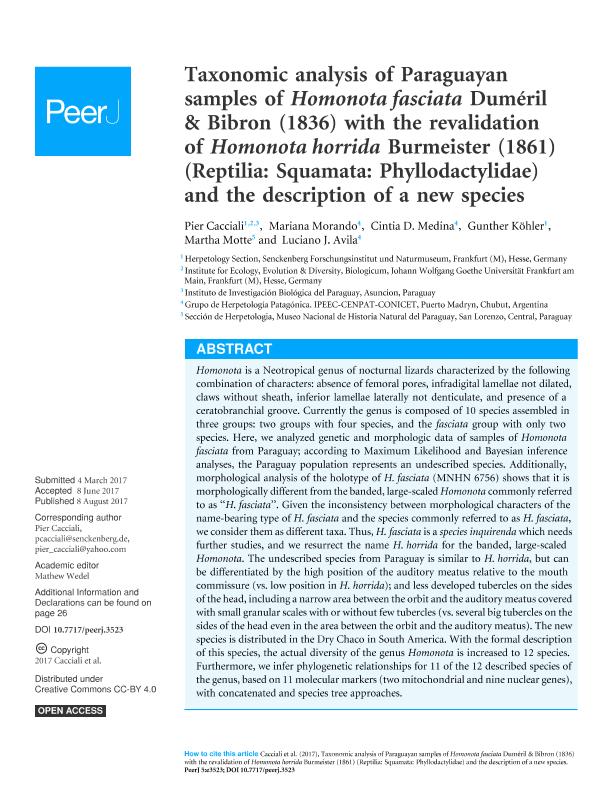Mostrar el registro sencillo del ítem
dc.contributor.author
Cacciali, Pier
dc.contributor.author
Morando, Mariana

dc.contributor.author
Medina, Cintia Débora

dc.contributor.author
Köhler, Gunther
dc.contributor.author
Motte, Martha
dc.contributor.author
Avila, Luciano Javier

dc.date.available
2018-02-14T21:04:15Z
dc.date.issued
2017-08-08
dc.identifier.citation
Cacciali, Pier; Morando, Mariana; Medina, Cintia Débora; Köhler, Gunther; Motte, Martha; et al.; Taxonomic analysis of Paraguayan samples of Homonota fasciata Duméril & Bibron (1836) with the revalidation of Homonota horrida Burmeister (1861) (Reptilia: Squamata: Phyllodactylidae) and the description of a new species; PeerJ Inc.; PeerJ; 2017; 8; 8-8-2017; 1-31
dc.identifier.issn
2167-8359
dc.identifier.uri
http://hdl.handle.net/11336/36489
dc.description.abstract
Homonota is a Neotropical genus of nocturnal lizards characterized by the following combination of characters: absence of femoral pores, infradigital lamellae not dilated, claws without sheath, inferior lamellae laterally not denticulate, and presence of a ceratobranchial groove. Currently the genus is composed of 10 species assembled in three groups: two groups with four species, and the fasciata group with only two species. Here, we analyzed genetic and morphologic data of samples of Homonota fasciata from Paraguay; according to Maximum Likelihood and Bayesian inference analyses, the Paraguay population represents an undescribed species. Additionally, morphological analysis of the holotype of H. fasciata (MNHN 6756) shows that it is morphologically different from the banded, large-scaled Homonota commonly referred to as “H. fasciata”. Given the inconsistency between morphological characters of the name-bearing type of H. fasciata and the species commonly referred to as H. fasciata, we consider them as different taxa. Thus, H. fasciata is a species inquirenda which needs further studies, and we resurrect the name H. horrida for the banded, large-scaled Homonota. The undescribed species from Paraguay is similar to H. horrida, but can be differentiated by the high position of the auditory meatus relative to the mouth commissure (vs. low position in H. horrida); and less developed tubercles on the sides of the head, including a narrow area between the orbit and the auditory meatus covered with small granular scales with or without few tubercles (vs. several big tubercles on the sides of the head even in the area between the orbit and the auditory meatus). The new species is distributed in the Dry Chaco in South America. With the formal description of this species, the actual diversity of the genus Homonota is increased to 12 species. Furthermore, we infer phylogenetic relationships for 11 of the 12 described species of the genus, based on 11 molecular markers (two mitochondrial and nine nuclear genes), with concatenated and species tree approaches.
dc.format
application/pdf
dc.language.iso
eng
dc.publisher
PeerJ Inc.
dc.rights
info:eu-repo/semantics/openAccess
dc.rights.uri
https://creativecommons.org/licenses/by-nc-sa/2.5/ar/
dc.subject
Chaco
dc.subject
Gekkota
dc.subject
Nomenclatural Acts
dc.subject
Phylogeny
dc.subject
South America
dc.subject.classification
Otras Ciencias Biológicas

dc.subject.classification
Ciencias Biológicas

dc.subject.classification
CIENCIAS NATURALES Y EXACTAS

dc.title
Taxonomic analysis of Paraguayan samples of Homonota fasciata Duméril & Bibron (1836) with the revalidation of Homonota horrida Burmeister (1861) (Reptilia: Squamata: Phyllodactylidae) and the description of a new species
dc.type
info:eu-repo/semantics/article
dc.type
info:ar-repo/semantics/artículo
dc.type
info:eu-repo/semantics/publishedVersion
dc.date.updated
2017-12-04T18:10:26Z
dc.journal.volume
2017
dc.journal.number
8
dc.journal.pagination
1-31
dc.journal.pais
Estados Unidos

dc.description.fil
Fil: Cacciali, Pier. Goethe Universitat Frankfurt; Alemania. Instituto de InvestigaciÛn BiolÛgica del Paraguay; Paraguay
dc.description.fil
Fil: Morando, Mariana. Consejo Nacional de Investigaciones Científicas y Técnicas. Centro Científico Tecnológico Conicet - Centro Nacional Patagónico. Instituto Patagónico para el Estudio de los Ecosistemas Continentales; Argentina
dc.description.fil
Fil: Medina, Cintia Débora. Consejo Nacional de Investigaciones Científicas y Técnicas. Centro Nacional Patagónico; Argentina
dc.description.fil
Fil: Köhler, Gunther. Senckenberg Forschungsinstitut und Naturmuseu; Alemania
dc.description.fil
Fil: Motte, Martha. , Museo Nacional de Historia Natural del Paraguay; Paraguay
dc.description.fil
Fil: Avila, Luciano Javier. Consejo Nacional de Investigaciones Científicas y Técnicas. Centro Científico Tecnológico Conicet - Centro Nacional Patagónico. Instituto Patagónico para el Estudio de los Ecosistemas Continentales; Argentina
dc.journal.title
PeerJ
dc.relation.alternativeid
info:eu-repo/semantics/altIdentifier/url/https://peerj.com/articles/3523
dc.relation.alternativeid
info:eu-repo/semantics/altIdentifier/doi/http://dx.doi.org/10.7717/peerj.3523
Archivos asociados
